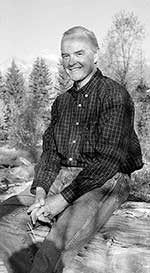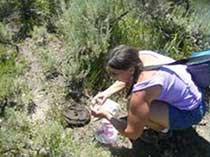
The Boyd Evison Graduate Research Fellowship is sponsored by Grand Teton Association. The call for 2026 proposals is open until February 16, 2026.
The Evison Fellowship was established in memory of Boyd Evison to honor his dedicated service to both the National Park Service and the Grand Teton Association. Evison retired in 1994 after an exemplary 42-year career with the National Park Service in which he rose from park ranger to regional director in parks from Alaska to the Rocky Mountain Region. After retiring from government service, he became executive director of the park's primary interpretive and educational partner, the Grand Teton Association, until his death in October 2002. Following Boyd's vision, the Evison Fellowship encourages scientific and conservation-related research in the Greater Yellowstone Ecosystem to help shape wise management decisions and maintain healthy natural resources. It provides $15,000 in support for highly motivated graduate students working on completion of a master's or Ph.D. degree in the biosciences, geosciences, or social sciences. 
Evison Fellowship ProjectsThe Grand Teton Association awarded the first fellowship in 2005. Students awarded the grant provide useful research to resource managers in the Greater Yellowstone Ecosystem. Previous award winners and their projects include: 2017 Danielle Fagre, University of Montana; Avian Community Responses to Bison Grazing in North American Intermountain Grasslands. 2015 Lauren Abbott, Penn State University; Exploring vertical wilderness in the acoustic environment. 2014 Kellen N. Nelson, University of Wyoming; Drivers of fuels, flammability, and fire behavior in young, post-fire lodgepole pine forests. 2013 Susma Giri, University of Wyoming; Interactive effects of temperature and parasites in native bumblebees of Grand Teton National Park, Wyoming. 2012 Darren Larsen, University of Colorado; Deglaciation and postglacial environmental changes in the Teton Mountain Range recorded at Jenny Lake, Grand Teton National Park, WY. 2011 Stefan Ekernas, University of Montana; Climate change and food webs: jackrabbits, pronghorn, and coyotes in southern Greater Yellowstone. 2010 James Meadow, Montana State University; Geothermal soil ecology in Yellowstone National Park. 2009 Nicholas Dowie, University of Wyoming; Exploring symbiosis between plants Pterospora andromeda (pinedrops) and Sarcodes sanguinea (snow plant) and fungus in the Greater Yellowstone Ecosystem. 2008 Emilene Ostlind, University of Wyoming; The perilous journey of Wyoming's migrating pronghorn. 2007 Lyman Persico, University of New Mexico; Natural and historical variability in fluvial processes, beaver activity, and climate in the Greater Yellowstone Ecosystem. 2006 Ericka Pilcher, Colorado State University; Understanding and managing soundscapes in the national parks: Grand Teton National Park. 2005 Florence Gardipee, University of Montana; Development of fecal DNA sampling methods to assess genetic population structure of Greater Yellowstone bison. 
Apply to the Evison FellowshipBoyd Evison Graduate Research Fellowship Application |
Last updated: December 10, 2025
